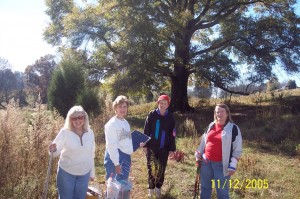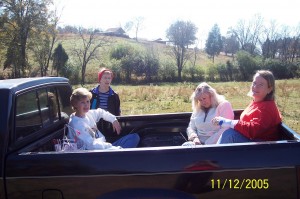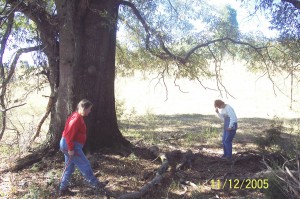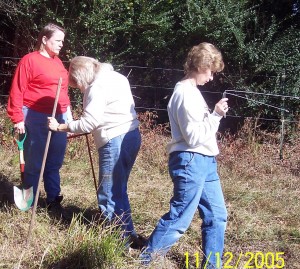By John Hoyle Burleson
While researching our Burleson Family I have spent countless hours in courthouses and libraries. As a member of the Burleson Family Research Group I have had the honor to participate in the preservation of Burleson Cemeteries. The first project was cleaning and fencing the cemetery where Isaac Sr. is buried; then placing a marker for Isaac Jr. and wife Katherine Burleson; the BFRG has also cleaned and fenced Burleson Cemeteries I and II and helped clean and reclaim The Harwood cemetery that is the resting place of Sarah Harwood Burleson, wife of Grandpa Billie Burleson. Most of the remainder of the clan was buried in church cemeteries. I have gained much respect for our ancestors and learned the importance of preserving the hollowed grounds.
The Stanly County Genealogical Society (which I am also a member) is in the process of recording the abandoned cemeteries in Stanly County for publication. This project is no easy task but is in the very capable hands of Pam Holbrook and Priscilla Clarke. My initial participation was to escort them to the cemeteries I knew of. Sometimes we could get to the site only by crossing through fields, woods, and streams. Many times we would have to cut brush and briars with a machete to reveal any tombstones. To an inexperienced eye no cemetery would be visible, but after locating over 120 cemeteries, Pam and Priscilla developed very trained eyes. If anyone can locate a lost cemetery, these gals can!
 Getting back to my Burleson Research, I was fortunate enough to obtain from Bobbie Nell Burleson Efird a copy of the Efird book published in 1964 by Judge Oscar Efird. There were many Burleson and Efird marriages in Stanly County, I am a grandchild of one of these; Ada Efird married John F.
Getting back to my Burleson Research, I was fortunate enough to obtain from Bobbie Nell Burleson Efird a copy of the Efird book published in 1964 by Judge Oscar Efird. There were many Burleson and Efird marriages in Stanly County, I am a grandchild of one of these; Ada Efird married John F. ![]() Burleson in 1903. Her line is Adam Timothy and Jennie Harkey, Nathaniel Parker Efird and Eve Coble, Jacob John and Catharine Cagle, and then Jacob Efird and Elizabeth Dove, who were the original Efird settlers in what is now Stanly County. Jacob was born in Wurttemberg in Southern Germany as Jacob Ehrenfried in 1763. He migrated to Pennsylvania in 1773 with his mother and father. He came down the Great Wagon Road to Cabarrus County in 1783 and finely settled at the mouth of Little Bear Creek prior to 1816. Jacob prospered
Burleson in 1903. Her line is Adam Timothy and Jennie Harkey, Nathaniel Parker Efird and Eve Coble, Jacob John and Catharine Cagle, and then Jacob Efird and Elizabeth Dove, who were the original Efird settlers in what is now Stanly County. Jacob was born in Wurttemberg in Southern Germany as Jacob Ehrenfried in 1763. He migrated to Pennsylvania in 1773 with his mother and father. He came down the Great Wagon Road to Cabarrus County in 1783 and finely settled at the mouth of Little Bear Creek prior to 1816. Jacob prospered
and raised eight children. In 1827 Jacob called a meeting of his children to deal with the same problem that many German families had, their surname, Ehrenfried, was being anglized in many different ways. The family was already prominent in the area. Later in 1841 Jacob was one of the commissioners that created and divided Stanly County from Montgomery County. By the end of the family meeting, they decided to simplify the name to Efird and it remains so today.
Jacob died in 1845 and was buried in the family cemetery somewhere on Jacob’s original 200-acre farm. There were approximately 30 graves in this cemetery according to Judge Efird`s book. After the second generation of Efird owners, this land changed hands many times until the present. The graves were originally said to be well marked with nice tombstones, many of marble, but all have since disappeared.
 Page 51 of the Efird book states, “John Soloman Efird, who was reared in the community in which the Efird originally settled and knew early Efird history, told Lily Carter Hoffman, an Efird descendant, on his death bed in a Charlotte, North Carolina hospital, that he knew where the old Efird graveyard was.” He died in 1927 at age 70. This part tells me that all physical signs were gone, long before 1927 and only existed in a few local’s memory. My curiosity was beginning to stir. The location of the cemetery has been a mystery for well over 100 years. Could it be found today? As a grandson of Ada Efird and great-great-great-great-grandson of Jacob Efird, I would like to try. As a member of the Stanly County Genealogical Society the resting place of a founding father of Stanly County needs to be known.
Page 51 of the Efird book states, “John Soloman Efird, who was reared in the community in which the Efird originally settled and knew early Efird history, told Lily Carter Hoffman, an Efird descendant, on his death bed in a Charlotte, North Carolina hospital, that he knew where the old Efird graveyard was.” He died in 1927 at age 70. This part tells me that all physical signs were gone, long before 1927 and only existed in a few local’s memory. My curiosity was beginning to stir. The location of the cemetery has been a mystery for well over 100 years. Could it be found today? As a grandson of Ada Efird and great-great-great-great-grandson of Jacob Efird, I would like to try. As a member of the Stanly County Genealogical Society the resting place of a founding father of Stanly County needs to be known.
I began to reread the Efird book from cover to cover. Judge Efird states the location was one-quarter mile east of St. Martin Church. This land was purchased by Worth Almond and his wife Nora Burleson Almond approximately 50 years ago and has been passed down to their daughters, Katherine Almond Talbert and Nancy Almond Burleson. Katherine and Nancy and myself are first cousins and share the same line of Efird decent.
Finding the lost cemetery was becoming a possibility after talking to Katherine and obtaining her permission to conduct a search. A lot of detective work would have to be done. The next couple of weeks were spent taking notes and studying all the information from the Efird book, which was very vague. Some of the clues are:
- Jacob’s house was built into a hillside on the North side of the old road that went toward what is now Oakboro. (The trouble is the house is long gone and the road no longer exists.)
- The cemetery was located to one side of the house. (Which side?)
- From the front porch, past the spring (which direction was it facing?) the cemetery could be seen.
- The springs are the only physical clues that still exist.
By studying the contour line on a geodetic map, I plotted where I thought the “Old Oakboro Road” would have been, I then looked for a hillside that had the right contour to allow a two story log house to be set into the hill (the floor of the first level extended into the hill with the second level being ground level on the back of the house only). I plotted this possible location on the map. The next step was to find a suitable hill for the cemetery “past the springs”. I plotted this location on my map. I checked and rechecked all my information, clues and my contour map. By using my 22 years of military experience of using and teaching the use of a contour map, I was confident I had plotted the most likely spot. But how could I prove it? All markings and tombstones had disappeared over 100 years before. I needed help. It was time to call for the “Ghost Busters”! At the next Genealogical Society meeting I gave Pam and Priscilla a copy of my information from the book along with a copy of my map. They were ready to give it a try but they would have to use their special weapon that earned them the name “Ghost Busters”, the dowsing rods. I’m sure many of you do not believe that dowsing works, I didn’t either, but I have witnessed Pam and Priscilla using them and it works every time. I saw them locate the slave graves that were known to be buried outside the Motley Cemetery, but not marked. By dowsing unmarked spaces in a cemetery they can determine if it is vacant. They have determined the boundaries of many cemeteries. I am now a believer!
With another call to Katherine, Saturday, November 11, 2005 was selected to go exploring. At 10::00 AM Saturday morning my wife Nancy and I met Pam and Priscilla and went to Katherine’s house to pick her up. The search area is now in a cow pasture of about 40 acres. At the pasture gate our host Katherine Talbert opened the gate and all five of us loaded into my pick-up truck and we drove through the pasture. At the spring there are two tremendous oak trees the size and age surely makes them “Witness Trees” as they were standing during Jacob’s life time. We parked near the first oak in what is clearly the original roadbed of the Old Oakboro Road. This was one of the clues and my plotting was accurate. I got out of the truck and looked up the hill where I thought the dugout of the house would be, but I didn’t see it. Could I have been right about the road and wrong about the house? Too late for second-guessing, now the search team was on the grounds with loads of tools in hand asking me, “Where do we start?” We walked past the huge water oak, past the spring and set down the buckets that contained the shaving cream, squeegee, talc powder, and magnifying glasses; materials that are used to highlight and bring out lettering on tombstones.
 As I’m writing this I am trying not to brag…really, but this is what happened next. As my wife Nancy was explaining to Katherine what some of the tools were used for, Pam Holbrook and Priscilla Clark were taking out the dowsing rods. I showed everyone my map where I had marked the area where we were standing on. I made my final prediction by saying, “I believe the cemetery was on this ridge and would be found somewhere between here and the creek.”
As I’m writing this I am trying not to brag…really, but this is what happened next. As my wife Nancy was explaining to Katherine what some of the tools were used for, Pam Holbrook and Priscilla Clark were taking out the dowsing rods. I showed everyone my map where I had marked the area where we were standing on. I made my final prediction by saying, “I believe the cemetery was on this ridge and would be found somewhere between here and the creek.”
As Pam and Priscilla took up their dowsing rods and started walking, the rods crossed with in the first five steps. Pam looked back over her shoulder to see if anyone else saw it. Four more feet and the rods crossed again. This time everyone saw it! Could this be happening? Everyone was excited now and picked up a set of rods. After twenty minutes or so we started getting down to business by walking in a grid through the whole area. We located what we believed were 43 sites, in four different rows. We walked the area outside the grid for 100 yards with no hits at all. I feel the tombstones were removed on purpose over 100 years ago as judge Efird suggested. There is one adjoining area that is overgrown that we could not check, but we intend to go back again to look for pieces of tombstone, which will be physical evidence. This had been a very exciting morning and successful venture; the only mystery now is the location of Jacob’s house site.
 We were loaded back in the truck by 1:00 PM and heading back up the pasture. We had only gone 100 yards from the springs and there, ten feet from the old roadbed, was a clearly identifiable excavation approximately 20 feet by 40 feet into the east slope of the hill. No doubt this is the site of Jacob Efird’s House that he built almost 200 years ago just as it was described in Judge Efird’s book.
We were loaded back in the truck by 1:00 PM and heading back up the pasture. We had only gone 100 yards from the springs and there, ten feet from the old roadbed, was a clearly identifiable excavation approximately 20 feet by 40 feet into the east slope of the hill. No doubt this is the site of Jacob Efird’s House that he built almost 200 years ago just as it was described in Judge Efird’s book.
Back at the highway as Katherine was closing the cattle gate I realized that the five of us today had just accomplished a task that no one has been able to do in over a hundred years. The memory of the emigrants, Jacob Efird and his family, will not be lost in the future.
Jacob Efird settled at the mouth of Little Bear Creek prior to 1806. He built and owned the first gristmill and sawmill in that part of the state. He organized St. Martin Luthern Church and was instrumental in organizing Flat Rock Lutheran Church in Locust. As a community leader he was one of the nine men appointed by the State Legislature in 1841 to divide Montgomery County and establish the new county of Stanly and also establish its’ courts and government.
BFRG members that are Efird descendants include:
- L. B. Teeter Bobby Burleson
- John H. Burleson Hazel Hopkins
- Daniel S. Burleson Donald K. Burleson
- Clegg Burleson Kathleen Efird
- Retha Burleson Bobbie Nell Efird
- Kenneth Efird
